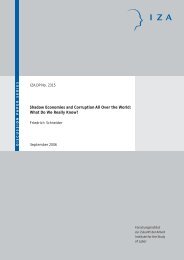The Great Recession of 2008-2009: Causes ... - Index of - IZA
The Great Recession of 2008-2009: Causes ... - Index of - IZA
The Great Recession of 2008-2009: Causes ... - Index of - IZA
- TAGS
- recession
- index
- ftp.iza.org
Create successful ePaper yourself
Turn your PDF publications into a flip-book with our unique Google optimized e-Paper software.
Loose monetary policy versus global imbalances<br />
Any post-mortem <strong>of</strong> the first decade <strong>of</strong> the 21st century cannot avoid the role that past US<br />
administrations have played in shaping it. When faced with a recession in 2001 following the<br />
bursting <strong>of</strong> the so-called ‘dot.com’ bubble, the US monetary authorities aggressively reduced<br />
the policy interest rate to unprecedented levels and thus fuelled a debt-financed consumption<br />
boom that led the way in boosting global aggregate demand. Interest rates in the US stood at<br />
just 1 per cent in 2003 (Figure 3). This ensured that the 2001 recession was shallow and<br />
short-lived, but it paradoxically sowed the seeds <strong>of</strong> the global recession <strong>of</strong> <strong>2008</strong>-<strong>2009</strong>. 18 In<br />
this respect, Taylor (<strong>2009</strong>) argues that over the period 2001-2006, the Federal Reserve’s<br />
policy was too loose resulting in interest rates that were far lower than suggested by the<br />
Taylor rule, which, in fact, was the largest deviation since the 1970s. 19 Indeed, the real<br />
(inflation-corrected) funds rate was negative for 31 months (from October 2002 to April<br />
2005).<br />
In contrast, Elmendorf (2007) claims that interest rates were only ‘a little too easy for too<br />
long, but the adjustments that appear optimal in hindsight would not have fundamentally<br />
altered the housing cycle and related developments.’ (Elmendorf 2007: 3). In any case, by<br />
focusing on a narrow definition <strong>of</strong> price stability, monetary policy in the US and elsewhere<br />
failed to tackle the ballooning bubble in asset markets. At the same time, Shiller (<strong>2008</strong>)<br />
points out that the housing boom in the US started in the late 1990s and thus predates the<br />
period <strong>of</strong> excessively low interest rates, but acknowledges that loose monetary policy<br />
contributed to the rapid growth in mortgages to sub-prime borrowers (see discussion below).<br />
Looking at the long end <strong>of</strong> the market, yields on US government bonds (Treasury Bills) were<br />
also unusually low during the pre-crisis period. 20 <strong>The</strong> low interest environment in the US<br />
persisted because oil exporters in the Middle East and export powerhouses – led by China in<br />
East Asia – developed a prodigious appetite for building up foreign exchange reserves in US<br />
18<br />
As argued by Reinhart and Rog<strong>of</strong>f (<strong>2009</strong>), the bursting <strong>of</strong> the dotcom bubble resulted in a relatively mild<br />
recession because it had not been accompanied by an unsustainable increase in debt levels.<br />
19<br />
<strong>The</strong> Taylor rule prescribes how a central bank should adjust its interest rate policy instrument in response to<br />
changes in inflation and macroeconomic activity. In particular, the rule implies that the real short-term interest<br />
rate should be determined according to three factors: (1) where actual inflation is relative to the targeted level;<br />
(2) how far economic activity is above or below its full employment level; and (3) what the level <strong>of</strong> the shortterm<br />
interest rate is that would be consistent with full employment. See, for example, Orphanides (2007).<br />
20<br />
See US Treasury data, http://www.ustreas.gov/tic/ticsec2.shtml<br />
15
















